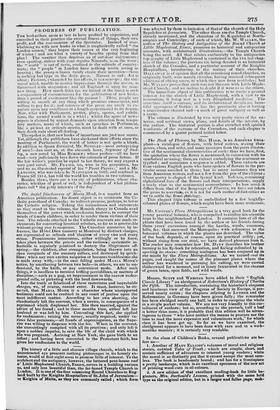The history of a little and obscure village church, which
to the uninstructed eye presents nothing picturesque in its homely ex- terior, would at first sight seem to promise little of interest. To the architect and the antiquary, however, the battered pent-house roof V Little Maplestead Church, Esssex, covers in a building curious as, and only less beautiful than, the far-famed Temple Church in London. It is one of the four remaining Round Churches in Eng- land built by the Knights Hospitallers of St.John of Jerusalem— or Knights of Malta, as they are commonly called ; which form was adopted by them in imitation of that of the church of the Holy Sepulchre at Jerusalem. The other three are the Temple Church,. already mentioned, and the churches of St. Sepulchre at North- ampton and Cambridge; of each of which, Mr. W. W A LLEN, the author of The History and Antiquities of the Round Church at Little Maplestead, Essex, promises us historical and antiquarian accounts, with architectural illustrations,—the Temple Church being the next. All that relates exclusively to the antiquarian topography of Little Maplestead is contained in the two last chap. ters of the volume; the previous six being devoted to an historical sketch of the Crusades, and a particular account of the Knights Hospitallers, introductory to the notices of their churches. Dm. L AWAY is of opinion that all the remaining round churches, as originally built, were merely circular, having received subsequent additions of Along naves, to which they now form vestibules; but Mr. W A L LE N proves that such was not the case with Little Maple- stead Church; and we incline to doubt if it were so in the others.
The immediate object of this publication is to excite a general interest for the church of Little Maplestead, with a view to its restoration, it being now in a very dilapidated condition. The structure itself is curious, and its architectural details are beau- tiful specimens of Gothic: it has the peculiarity also of having a semicircular chancel end—a mark of great antiquity as well as a rarity.
The volume is illustrated by two very pretty views of the ex- terior, and sectional views, plans, and details of the intrrior, by the author. The historical portion is also enriched with spirited wood-cuts of the costume of the Crusaders, and each chapter is commenced by a quaint pictural initial letter.


























 Previous page
Previous page